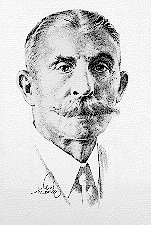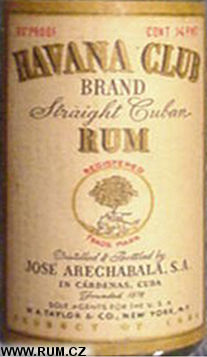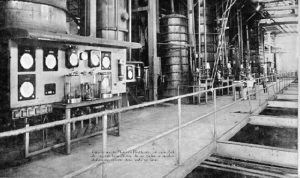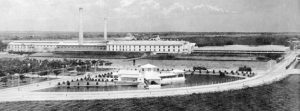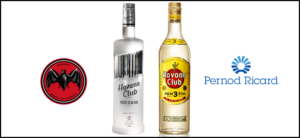![]() JOSÉ ARECHABALA: ORIGIN OF THE ‘HAVANA CLUB’ RUM. HISTORY.
JOSÉ ARECHABALA: ORIGIN OF THE ‘HAVANA CLUB’ RUM. HISTORY.
José Arechabala Aldama was born in Gordejuela, Vizcaya, on November 9, 1847. The sources consulted not allude to childhood to adolescence, but it is likely that they weren’t nothing buoyant, because with only 15 years he sought in Cuba better horizons. He arrived on the island on September 21, 1863 and worked first with his relative Antonio Galíndez Aldama, based in Matanzas, and then at the Bea home, dedicated to the provision of ships, the hardware and banking, something frequent then when the companies assumed the role of banks.
In 1878 entered to the game the Vizcaíno, who bought in installments to the heirs of Joaquín de Zulueta a still established in matancera city of Cardenas. He distilled the sweetness of seven or eight sugar mills in the area and received by sea raw Sagua la Grande and Yaguajay, and was valued at about 33 000 pesos gold and 167 000 pesos in bills. 1. in February 1880, the new owner enrolled him in the register under the name of La Vizcaya. From January 18, 1821, would operate under the trade name of J. Arechabala S. A. of the company founder presided over the company and work as shareholders their children Joanna, Carmela, Mercedes, José Antonio, José Nicolas. He would amass a huge capital in the field of alcohol distillation and refining of sugar and create the famous Havana Club rum.
José Arechabala died on March 15, 1923. It became owner of the factory of gas that fed the public lighting of Cardenas and gave city a theater that carried his name. Their actions are a reflection of his devotion to the culture and good taste. The industry itself was framed in a vast array of gardens and walks, where useful and beautiful, shook hands without was a great source of employment. Cárdenas was his adopted son.
In 1958 this industrial complex occupied an area of 600 000 square meters and consisted it of plants of jams, syrup, yeast and other products derived from sugar. It had a factory of liquors, stores sugar, maritime terminal, own aqueduct, service of cabotage and shipyard. In their soleras were kept permanently two million litres aging in oak barrels.
Producing anise, brandy, cream, cognac and Geneva branded Arechabala, the cognacs brands shrine and three trees, Arechabala 75 Añejo rum and other types of rums, in addition to the aforementioned Havana Club.
It represented, on the other hand, the Chivas Regal whisky and other drinks import. The sugar mills by force and progress, formed part of the company both in the province of Matanzas.
Havana Club rum is created.
On March 19, 1934 opened the liquor factory and started production of Havana Club rum. The Alco-Elite – pure, very demanded alcohol for medical purposes – was later added. Also the friendly and cognac. On May 29, 1935 opened the private Bar and the offices of the company at the Palace of the count of House Bayonne, in the square of the Cathedral of Havana. On July 18, 1936 they launched the production of jams. To develop them was adopted the most advanced technique, using selected raw materials to provide them with an exquisite flavour and expend them with an attractive presentation, which made them very popular inside and outside Cuba.
In March 1934, the company began to produce the fuel known as mofuco. What is considered pioneer of national fuel, using alcohol as a basis. When in 1943, the world war imposed rigid controls on gasoline, the Cuban Government claimed the company contest that ground transportation is not crippled, reaching Arechabala support up to 63 percent of the national consumption.
He had J. Arechabala S. A. an active participation in getting us to admit Cuban refined sugar. It was a hard struggle which, between 1928 and 1933, freed, along with other firms, against the American authorities, to settle and clarify the right of Cuba to export that product to us and avoid the closure of Cuban refineries as well.
Their productions were over those of its competitors. In 1956 La Vizcaya produced around six million liters of spirits and spirit of 95 degrees, adding to what were the almost 800 000 litres obtained by force and progress stations. They followed him in production order distillery hell – more than six million litres – and the spirits of Cuba, with five million in brands of rum and cream Aldabo, cognac Peralta and anise of the devil. The Cuban company of Alcohol appears with more than three million liters, of Santa Cruz, and legendary names, while Bacardi, the last of the row, appears only with 3 118 000 litres.
Of course there were disappointments and losses. The founder of the company lost and remade his fortune several times.
The hurricane of 1888, which swept the North coast of the island by the area of Cardenas and caused losses turned out disastrous for the rum. The same happened with flush of sea of 1933, causing damage to warehouses and docks, stills, tanks and barrels, buildings and boats, as well as loss of raw materials for 258 000 pesos. Harmful also were the two world wars, the fall in sugar prices and the economic crisis. And the moral troubles that shook this curious family, in which names are repeated and members end up marrying each other, which was part nothing more and nothing less than Carmelina Arechabala, which gave rise to a phrase that survives in the imagination of the Cuban, that of «live like Carmelina», to identify who leads a life gift free of gaps and concerns.
Something not clear at all to the scriptwriter happens at the end of the 1950s, when José Fermín Iturrioz leaves or they do it out of the firm that ran from 1926 and presided over since 1953, when he had to replace Carmen Arechabala – is not the Carmelina hint-, daughter of José Arechabala Aldama, the founder, and widow of José Arechabala Saiz, nephew of his father. To not vary, Iturrioz, who was the owner of the Josone removal, in Varadero, is substituted by José Arechabala Arechabala.
His departure meant for signing the loss of the station by force, which remained in the hands of Iturrioz. It had a capacity of ground of 250 000 pounds daily, 2 650 workers and 768 chivalry’s own lands.
Then…
After 1959 the factory named after José Antonio Echeverría, and in 1993, when was founded the Corporación Cuba Ron, a part of its infrastructure was destined to the creation of the Cárdenas rum. Production of this famous Winery portfolio includes Havana Club brands, ron Cubay and Sao Can brandy caneca formats. It also produces rums refining and Pearl of the North; This is their versions of white, Golden and añejo, collecting the good and genuine know-how of this ancient and famous rum.
Agencies/CiroBianchiRoss/Excerpt/InternetPhotos/Arnoldo Varona/TheCubanHistory.com
THE CUBAN HISTORY, HOLLYWOOD.
CUBA HOY/TODAY/ Raquel Pérez Díaz/Cartas de Cuba.
![]() JOSÉ ARECHABALA, ORIGEN DEL RON ‘HAVANA CLUB’. HISTORIA.
JOSÉ ARECHABALA, ORIGEN DEL RON ‘HAVANA CLUB’. HISTORIA.
José Arechabala Aldama nació en Gordejuela, Vizcaya, el 9 de noviembre de 1847. Las fuentes consultadas no aluden a su niñez ni a su adolescencia, pero lo seguro es que no fuesen nada boyantes, pues con solo 15 años buscó en Cuba mejores horizontes. Llegó a la Isla el 21 de septiembre de 1863 y trabajó primero con su pariente Antonio Galíndez Aldama, radicado en Matanzas, y luego en la casa Bea, dedicada a la consignación de buques, la ferretería y la banca, algo frecuente entonces cuando las empresas asumían el papel de los bancos.
En 1878 entró en el juego el vizcaíno, quien compró a plazos a los herederos de Joaquín de Zulueta un alambique establecido en la ciudad matancera de Cárdenas. Destilaba las mieles de siete u ocho ingenios azucareros de la zona y recibía por mar materia prima de Sagua la Grande y Yaguajay, y estaba valorado en unos 33 000 pesos oro y 167 000 pesos en billetes. El 1ro. de febrero de 1880, el nuevo propietario lo inscribía en el Registro Mercantil con el nombre de La Vizcaya. A partir del 18 de enero de 1821 operaría bajo la razón social de J. Arechabala S. A. Presidía la compañía el fundador de la firma y obraban como accionistas sus hijos Juana, Carmela, Mercedes, José Antonio y José Nicolás. Llegaría a amasar un capital enorme en el campo de la destilación de alcoholes y la refinación de azúcares y crearía el famoso ron Havana Club.
José Arechabala falleció el 15 de marzo de 1923. Llegó a ser propietario de la fábrica de gas que alimentaba el alumbrado público de Cárdenas y dotó a la ciudad de un teatro que llevó su nombre. Sus actos son reflejo de su devoción por la cultura y el buen gusto. La propia industria estaba enmarcada en un vasto conjunto de jardines y paseos, donde se daban la mano lo útil y lo bello, sin contar que fue una gran fuente de empleo. Cárdenas lo declaró su Hijo Adoptivo.
En 1958 este complejo fabril ocupaba un área de 600 000 metros cuadrados y lo conformaban plantas de confituras, levadura, sirope y otras producciones derivadas del azúcar. Contaba con una fábrica de licores, almacenes de azúcar, terminal marítima, acueducto propio, servicio de cabotaje y astillero. En sus soleras se mantenían de manera permanente dos millones de litros añejándose en toneles de robles.
Producía anís, aguardiente, cremas, coñac y ginebra con la marca Arechabala, los coñacs marcas Relicario y Tres Arbolitos, el ron añejo Arechabala 75 y otros tipos de rones, además del ya mencionado Havana Club.
Representaba, por otra parte, el whisky Chivas Regal y otras bebidas de importación. Formaban parte de la compañía los centrales azucareros Por Fuerza y Progreso, ambos en la provincia de Matanzas.
Se crea el Ron Havana Club.
El 19 de marzo de 1934 se inauguró la fábrica de licores y comenzó la producción de ron Havana Club. Más tarde se añadió el Alco-Elite —alcohol puro, muy demandado con fines sanitarios—. También los cordiales y el coñac. El 29 de mayo de 1935 abrieron el Bar Privado y las oficinas de la empresa en el palacio del Conde de Casa Bayona, en la Plaza de la Catedral de La Habana. El 18 de julio de 1936 pusieron en marcha la producción de confituras. Para elaborarlas se adoptó la técnica más avanzada, utilizándose materias primas selectas para dotarlas de un sabor exquisito y expenderlas con una presentación atractiva, lo que las hizo muy demandadas dentro y fuera de Cuba.
En marzo de 1934, la compañía comenzó a producir el carburante conocido como mofuco. Por lo que se le considera pionera del carburante nacional, utilizando el alcohol como base. Cuando en 1943, la guerra mundial impuso rígidos controles sobre la gasolina, el Gobierno cubano reclamó el concurso de la empresa para que el transporte terrestre no se paralizara, llegando Arechabala a soportar hasta el 63 por ciento del consumo nacional.
Tuvo J. Arechabala S. A. una activa participación en lograr que EE. UU. admitiera el azúcar refinado cubano. Fue una lucha denodada que entre 1928 y 1933 libró, junto con otras firmas, contra las autoridades norteamericanas, para afincar y esclarecer el derecho de Cuba a exportar ese producto a EE. UU. y evitar así el cierre de las refinerías cubanas.
Sus producciones superaban las de sus competidores. En 1956 La Vizcaya produjo alrededor de seis millones de litros de aguardientes y alcohol de 95 grados, a lo que se sumaban los casi 800 000 litros obtenidos en los centrales Por Fuerza y Progreso. Le seguían en orden de producción la destilería Infierno —más de seis millones de litros— y la Licorera de Cuba, con cinco millones en las marcas de ron y cremas Aldabó, coñac Peralta y Anís del Diablo. La Compañía Cubana de Alcohol aparece con algo más de tres millones de litros, de las denominaciones Santa Cruz y Legendario, en tanto que Bacardí, en el último de la fila, aparece solo con 3 118 000 litros.
Claro que hubo contrariedades y quebrantos. El fundador de la empresa perdió y rehízo su fortuna varias veces.
Resultó desastroso para la ronera el huracán de 1888, que arrasó la costa norte de la Isla por la zona de Cárdenas y ocasionó pérdidas cuantiosas. Igual ocurrió con el ras de mar de 1933, causante de daños en almacenes y muelles, alambiques, tanques y toneles, edificios y embarcaciones, así como pérdida de materias primas por 258 000 pesos. Perjudiciales fueron también las dos guerras mundiales, la caída de los precios del azúcar y las crisis económicas. Y las pesadumbres morales que sacudieron a esta curiosa familia, en la que los nombres se repiten y sus miembros terminan casándose entre sí, y de la que formó parte nada más y nada menos que Carmelina Arechabala, la que dio pie a una frase que sobrevive en el imaginario del cubano, esa de «vive como Carmelina», para identificar a quien lleva una vida regalada, libre de carencias y preocupaciones.
Algo no claro del todo para el escribidor sucede a finales de los años 50, cuando José Fermín Iturrioz sale o lo hacen salir de la firma que dirigía desde 1926 y presidía desde 1953, cuando le tocó sustituir a Carmen Arechabala —no es la Carmelina aludida—, hija de José Arechabala Aldama, el fundador, y viuda de José Arechabala Saiz, sobrino de su padre. Para no variar, Iturrioz, que era el propietario del Retiro Josone, en Varadero, es sustituido por José Arechabala Arechabala.
Su salida implicó para la firma la pérdida del central Por Fuerza, que permaneció en manos de Iturrioz. Tenía una capacidad de molida de 250 000 arrobas diarias, 2 650 trabajadores y 768 caballerías de tierras propias.
Después…
Después de 1959 la fábrica recibió el nombre de José Antonio Echeverría, y en 1993, cuando se fundó la corporación Cuba Ron, una parte de su infraestructura se destinó a la creación de la Ronera Cárdenas. La cartera de producción de esta afamada bodega contempla los formatos caneca de las marcas Havana Club, ron Cubay y el aguardiente Sao Can. Produce asimismo los rones Refino y Perla del Norte; este en sus versiones de blanco, dorado y añejo, que recoge el buen y genuino saber hacer de esta famosa y añeja ronera.
Agencies/CiroBianchiRoss/Excerpt/InternetPhotos/Arnoldo Varona/TheCubanHistory.com
THE CUBAN HISTORY, HOLLYWOOD.



